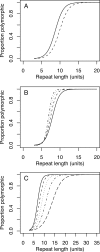Genome-wide analysis of microsatellite polymorphism in chicken circumventing the ascertainment bias
- PMID: 18356314
- PMCID: PMC2413155
- DOI: 10.1101/gr.075242.107
Genome-wide analysis of microsatellite polymorphism in chicken circumventing the ascertainment bias
Abstract
Studies of microsatellites evolution based on marker data almost inherently suffer from an ascertainment bias because there is selection for the most mutable and polymorphic loci during marker development. To circumvent this bias we took advantage of whole-genome shotgun sequence data from three unrelated chicken individuals that, when aligned to the genome reference sequence, give sequence information on two chromosomes from about one-fourth (375,000) of all microsatellite loci containing di- through pentanucleotide repeat motifs in the chicken genome. Polymorphism is seen at loci with as few as five repeat units, and the proportion of dimorphic loci then increases to 50% for sequences with approximately 10 repeat units, to reach a maximum of 75%-80% for sequences with 15 or more repeat units. For any given repeat length, polymorphism increases with decreasing GC content of repeat motifs for dinucleotides, nonhairpin-forming trinucleotides, and tetranucleotides. For trinucleotide repeats which are likely to form hairpin structures, polymorphism increases with increasing GC content, indicating that the relative stability of hairpins affects the rate of replication slippage. For any given repeat length, polymorphism is significantly lower for imperfect compared to perfect repeats and repeat interruptions occur in >15% of loci. However, interruptions are not randomly distributed within repeat arrays but are preferentially located toward the ends. There is negative correlation between microsatellite abundance and single nucleotide polymorphism (SNP) density, providing large-scale genomic support for the hypothesis that equilibrium microsatellite distributions are governed by a balance between rate of replication slippage and rate of point mutation.
Figures




References
-
- Adams R.I., Brown K.M., Hamilton M.B., Brown K.M., Hamilton M.B., Hamilton M.B. The impact of microsatellite electromorph size homoplasy on multilocus population structure estimates in a tropical tree (Corythophora alta) and an anadromous fish (Morone saxatilis) Mol. Ecol. 2004;13:2579–2588. - PubMed
-
- Bacolla A., Gellibolian R., Shimizu M., Amirhaeri S., Kang S., Ohshima K., Larson J.E., Harvey S.C., Stollar B.D., Wells R.D., Gellibolian R., Shimizu M., Amirhaeri S., Kang S., Ohshima K., Larson J.E., Harvey S.C., Stollar B.D., Wells R.D., Shimizu M., Amirhaeri S., Kang S., Ohshima K., Larson J.E., Harvey S.C., Stollar B.D., Wells R.D., Amirhaeri S., Kang S., Ohshima K., Larson J.E., Harvey S.C., Stollar B.D., Wells R.D., Kang S., Ohshima K., Larson J.E., Harvey S.C., Stollar B.D., Wells R.D., Ohshima K., Larson J.E., Harvey S.C., Stollar B.D., Wells R.D., Larson J.E., Harvey S.C., Stollar B.D., Wells R.D., Harvey S.C., Stollar B.D., Wells R.D., Stollar B.D., Wells R.D., Wells R.D. Flexible DNA: Genetically unstable CTG.CAG and CGG.CCG from human hereditary neuromuscular disease genes. J. Biol. Chem. 1997;272:16783–16792. - PubMed
-
- Bell G.I., Jurka J., Jurka J. The length distribution of perfect dimer repetitive DNA is consistent with its evolution by an unbiased single-step mutation process. J. Mol. Evol. 1997;44:414–421. - PubMed
Publication types
MeSH terms
LinkOut - more resources
Full Text Sources
Miscellaneous
